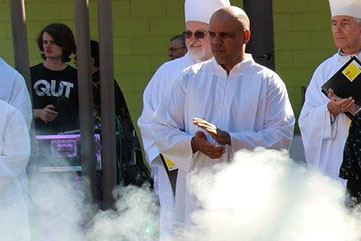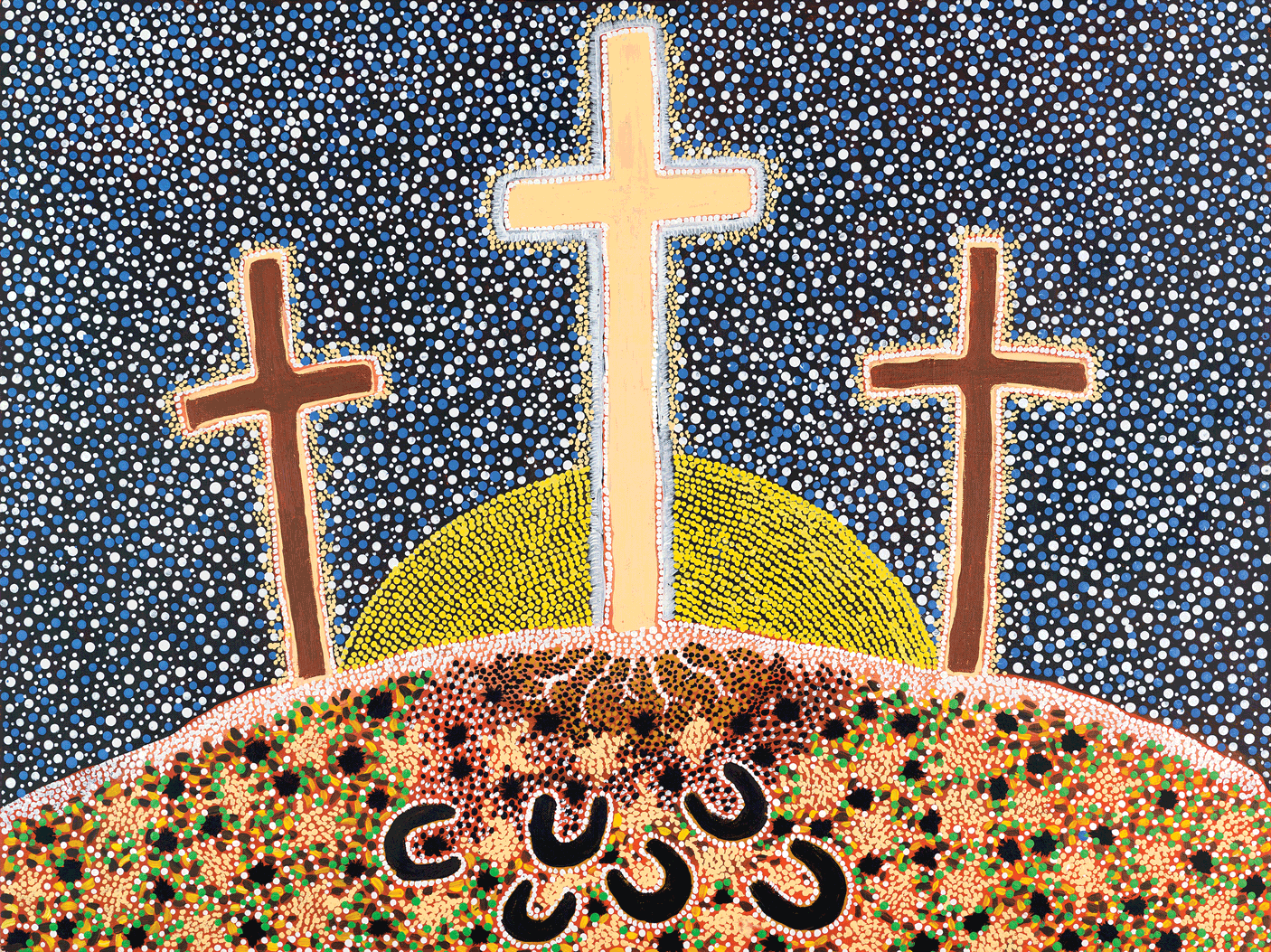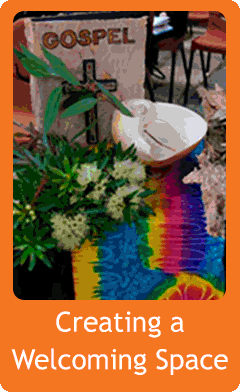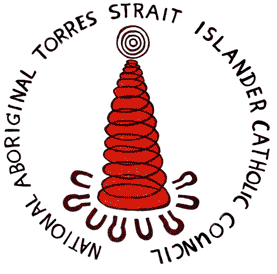
National Aboriginal and Torres Strait Islander Catholic Council
2017 Aboriginal and Torres Strait Islander Sunday Resources
Creating a welcoming space
Bringing to life Saint John Paul II’s vision of a universal and welcoming Church by embracing and including Aboriginal and Torres Strait Islander elements into the celebration of the Eucharist.
We acknowledge that God has been walking with the Aboriginal and Torres Strait Islander people, making his presence known through a living culture that has been maintained till this present time.
In many and varied ways God spoke to many ancient cultures through prophets and traditions, but know he speaks to us through Jesus Christ whom he appointed the heir of all things, through whom he also created the world (Heb 1:1-2)
Elements of Aboriginal culture can be included in the church’s liturgy – especially when Aboriginal people are members of the celebrating assembly. Please follow the suggestions given, and NATSICC strongly advise that you work closely with your Parish Priest and Liturgical team to ensure the suggestions conform with the Liturgical norms of the Roman Missal.
Involving your local Aboriginal or Islander Catholic Ministry (AICM)
Visit www.natsicc.org.au and go to ‘About NATSICC’ and click on your State or Territory to find your local AICM. These ministries work very hard to serve local Indigenous Catholics and do a lot of good in the community. You may be able to work together in preparing the Liturgy, sourcing speakers or presenters or learning more about Aboriginal and Torres Strait Islander Catholics in your area.
Language
Careful consideration needs to be given to determine which elements in the language of the people can be properly introduced into Liturgical celebrations. The suggestions below would be most appropriate to worshiping communities where traditional languages are predominantly used.
In other congregations, perhaps a word or phrase in local language could be included with the permission of local Aboriginal speakers.
How Language can be used:
*The readings can be read in Language from a recognised scripture translation.
*1 or more of the Prayers of the Faithful can be in Language – as above.
*Stanzas of a hymn can be translated into Language – as above.
Presentation of Gifts
In some areas the coolamon is used to carry the bread to the altar. In the absence of Aboriginal and Torres Strait Islander people participating in the celebration, a coolamon can be placed in front of the altar as a symbol of the non presence of Aboriginal and Torres Strait Islander brothers and sisters at the table. (Alternative/additional Aboriginal and Torres Strait Islander gifts: a boomerang, woomera, Indigenous painting, clap sticks)
All gifts presented are intended to be given to the poor; they would not be returned to the giver, but shared with others.
Ceremonies
The following ceremonies are ways that Aboriginal and Torres Strait Islander communities enhance and enrich the Liturgy, bringing the gift of culture and tradition to the Catholic Church in Australia. Local Aboriginal and Torres Strait Islander people must conduct these ceremonies and should be involved in the planning process.
Smoking Ceremonies
 Traditionally celebrated by Aboriginal people. Since the beginning of time our ancestors used to smoke away evil spirits and receive the good spirit.
Traditionally celebrated by Aboriginal people. Since the beginning of time our ancestors used to smoke away evil spirits and receive the good spirit.
We acknowledge Aboriginal Elders to lead Smoking Ceremony.
“Today we share with you one of the oldest living ceremonies, to remove our sins and ask for forgiveness. We invite you now to share our smoking ceremony like our ancestors have done for thousands of years.”
A Rite of Water Blessing
Traditionally in the Roman Rite the water ritual is the Asperges to acknowledge our baptism. This replaces the Penitential Act. In the absence of Aboriginal Christians the Asperges could be introduced with the words:
"Water to Aboriginal people, and to all of us, is always a sign of God’s peace and fulfilment in everything that is good; the promise of food, of God’s love, and protection, and a sign of the new life in Christ, which in Baptism we have all received."
It is customary in some areas, when Aboriginal people gather for important ceremonies to use water. Water containers can be a large shell or coolamon and a small branch from an appropriate native tree can be used to sprinkle the water. Please collaborate with your local Aboriginal and Torres
Strait Islander group to ensure this rite of water blessing is appropriate.
A suggested text for this blessing is:
"Lord, make us feel your invitation to ‘come to the water’. At the very beginning you blessed the water, your great gift to us, and now we ask that your blessing be renewed in this water here today. We ask that through this water blessing we will all be renewed."
Art
 Art is used to enhance the beauty of a Church building, and as a means of assisting the community to celebrate, meet God and pray. The art should be truly significant in the life and tradition of the people. Communities should enjoy freedom of expression, as it enhances the beauty of the building and liturgical rites, endowing the respect which is their due.
Art is used to enhance the beauty of a Church building, and as a means of assisting the community to celebrate, meet God and pray. The art should be truly significant in the life and tradition of the people. Communities should enjoy freedom of expression, as it enhances the beauty of the building and liturgical rites, endowing the respect which is their due.
Churches around Australia house Aboriginal and Torres Strait Islander art, side by side with western images. The amalgamation of traditional and western artwork transforms the church into a living symbol of contemporary society and forms tangible representation of Reconciliation.
Music / Song / Dance
Music and singing, which express the soul of the people, have pride of place in the liturgy. Music forms, melodies and musical instruments could be used in divine worship as long as they are suitable or can be made suitable, for sacred use, and provided they are in accord with the dignity of the place of worship and truly contribute to the uplifting of the faithful.
How music can be used:-
*Didge and clapsticks can accompany the choir.
*Didge and clapsticks together with other instruments can be used for reflective music.
*A hymn can be sung in language. If a stanza of a hymn is translated it should be able to be used at an appropriate time in the liturgy.
*Dance can be incorporated into the liturgy, especially as a procession – entrance, or gifts.
Actions
The gestures and postures of the assembly are signs of its unity and express its active participation and foster the spiritual attitude of the participants.
Example:
The message stick (where appropriate) can accompany the entrance procession and be placed at the ambo. In some Aboriginal communities the message stick is a communication tool, a symbol of the word being proclaimed to be passed onto others.


National Aboriginal and Torres Strait Islander Catholic Council
'The peak Indigenous advisory body to the Catholic Church'
80C Payneham Rd.
Stepney SA 5069
www.natsicc.org.au | craig@natsicc.org.au | 08 8363 2963
